The world’s Forest, Land and Agriculture (FLAG) sector is responsible for approximately 25% of net anthropogenic emissions globally, but it also has the potential to absorb a significant amount of existing emissions from the atmosphere. To address this gap in emissions accounting and reduction, the Science Based Target initiative (SBTi) introduced new FLAG guidance that requires SBTi committed companies to account for their FLAG emissions and provide pathways for decarbonization in line with the 1.5C scenario. In this article, we help companies navigate the numerous important pieces of information contained in SBTi’s new FLAG guidance by breaking it down into the following components:
- The need for the FLAG guidance and its requirements
- The criteria required to set a FLAG science-based target
- Impact of calculating FLAG emissions
- Pathways for FLAG target-setting
- Timeline of FLAG target compliance and additional requirements
The need for a FLAG guidance
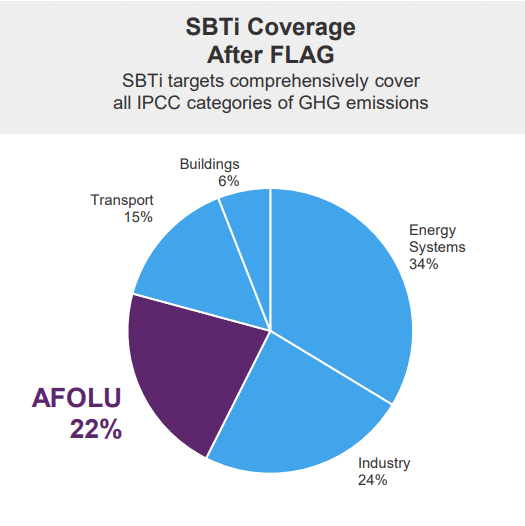
Source: SBTi Forest, Land and Agriculture (FLAG) / Launch of FLAG guidance and tool PDF, p.11
Companies have a relatively mature understanding of the requirements for energy and process-related emissions reporting. Guidance from organizations like Greenhouse Gas Protocol and CDP is well-established, and at least basic data sources exist to quantify direct emissions from primary sources of emissions. However, emissions from the forest, land and agriculture sector have been historically calculated at country, region or global level (usually addressed as LULUCF or AFOLU sector emissions) and not included in corporate emissions inventory. GHG accounting criteria and recommendations on FLAG emissions have been historically poorly addressed and there has been no framework on target setting for these emissions. Only a few companies have been accounting for and reporting these emissions at some level.
The reason for this is lack of data and methodology, resulting in around 22% of global emissions from the land sector not being accounted for appropriately in corporate carbon footprint calculations. Based on SBTi assessment, mitigation measures in the FLAG sector offer a potential 30% reduction of global emissions by 2050 through its carbon sink capacity. In this context, both SBTi and GHG Protocol started working on accounting and target setting frameworks for these land sector emissions in order to increase the coverage of actions and bring the world closer to reaching the global emissions level to 1.5C degrees.
The SBTi FLAG project developed guidance and a tool for how to set a science-based target for land-related emissions. The GHG Protocol’s Land Sector and Removals Initiative is a complementary project developing guidance on how to account for land-related emissions and removals (both technological and natural) within a carbon inventory. This blog series is focused primarily on SBTi’s target-setting guidance.
By providing tools and clarity to the FLAG sector, companies finally have the structure they need to manage the 22% of global emissions that result from this sector, which is critical to global emissions reduction.
Criteria to set a FLAG science-based target
The SBTi FLAG guidance will ultimately affect all companies setting a science-based target. SBTi requires all companies that have, or plan to have, an SBT to calculate/estimate their FLAG emissions in their direct operations and supply chain in line with GHG Protocol’s Land Sector and Removals Guidance. Depending on the final share of FLAG emissions in their total scope 1, 2 and 3 emissions, companies will have various target-setting requirements and/or expectations for FLAG-related emissions.
SBTi requires companies that meet one of the following two criteria to set a FLAG science-based target:
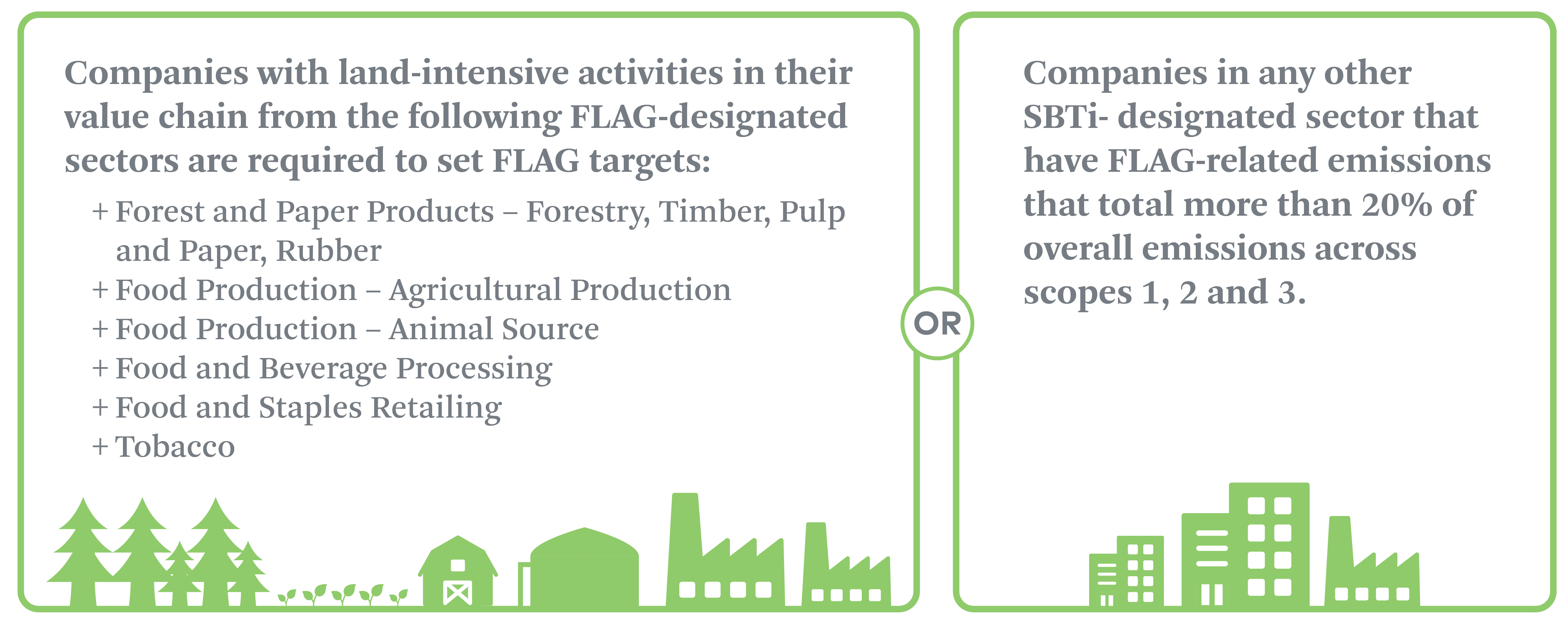
For companies with FLAG-related emissions that fall below the 20% threshold, it is still recommended to set a FLAG target, though not a requirement. If the company chooses not to set a FLAG target, FLAG-related emissions still must be included in the overall target boundary and accounted for, together with energy/industry (non-FLAG) targets for a complete GHG inventory. In this case, nature-based emissions removals cannot be accounted for in calculating progress towards an emissions reduction target.
Ultimately, all companies will need to account for FLAG-related emissions when setting a science-based target. Depending on the sector and materiality of their FLAG-related emissions, companies are required to either set a separate FLAG target or include these emissions in their non-FLAG target.
Impact on calculating FLAG emissions
Organizations setting FLAG targets will be introduced to the following new categories of emissions accounting: emissions from land use change (LUC), emissions from land management, and emission sinks (also called carbon removals). Base year FLAG emissions must be calculated in line with GHG Protocol’s Land Sector and Removals Guidance, which is set to be finalized in early 2023.
There are several challenges connected to the FLAG emissions calculation that will have to be addressed by SBTi-committers:
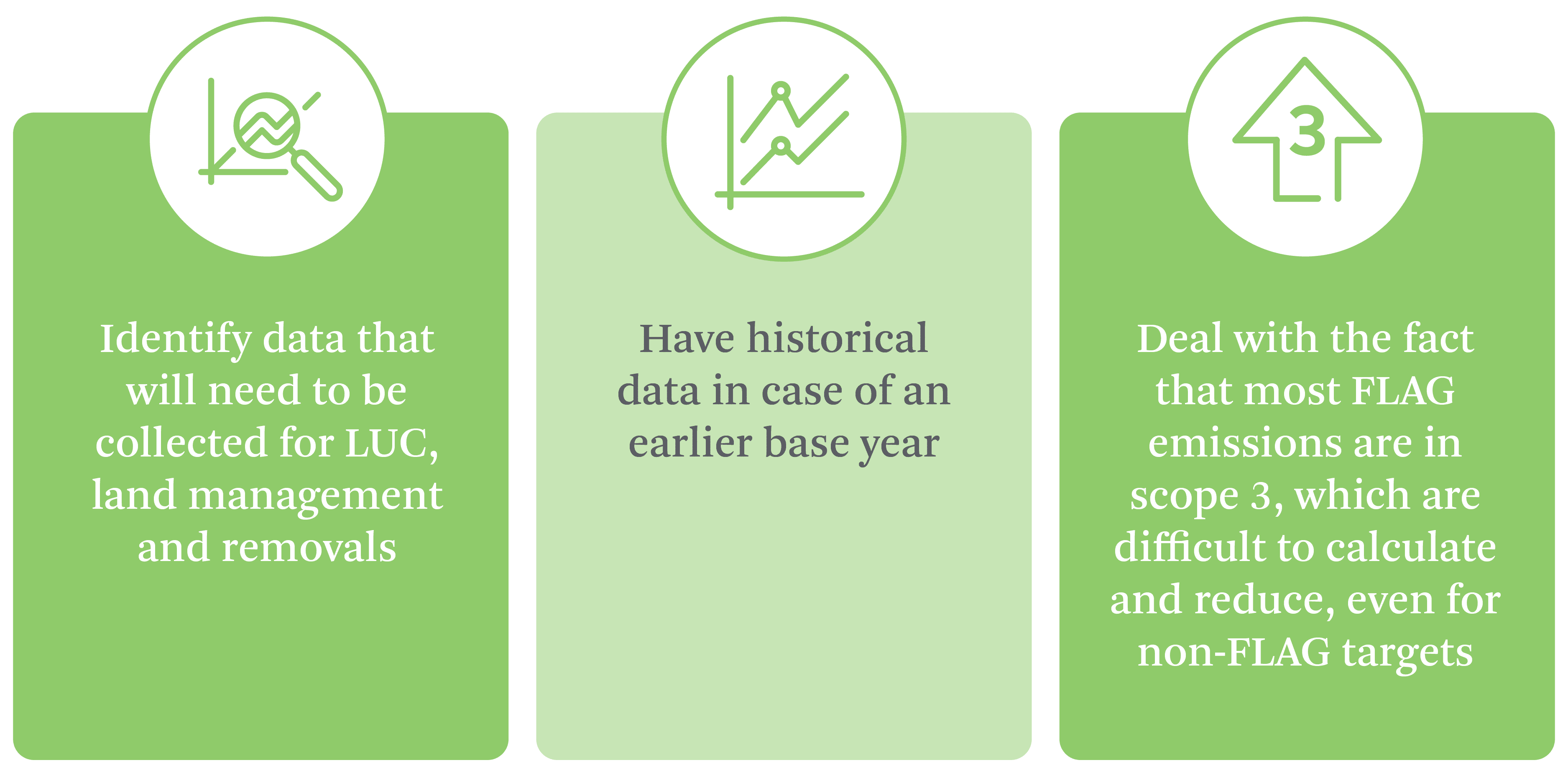
FLAG and non-FLAG targets need to be tracked and reported separately. This means that FLAG-related removals (i.e. biogenic removals) cannot be used to compensate for non-FLAG emissions.
The two pathways for FLAG target-setting
SBTi developed two pathways for FLAG target setting:
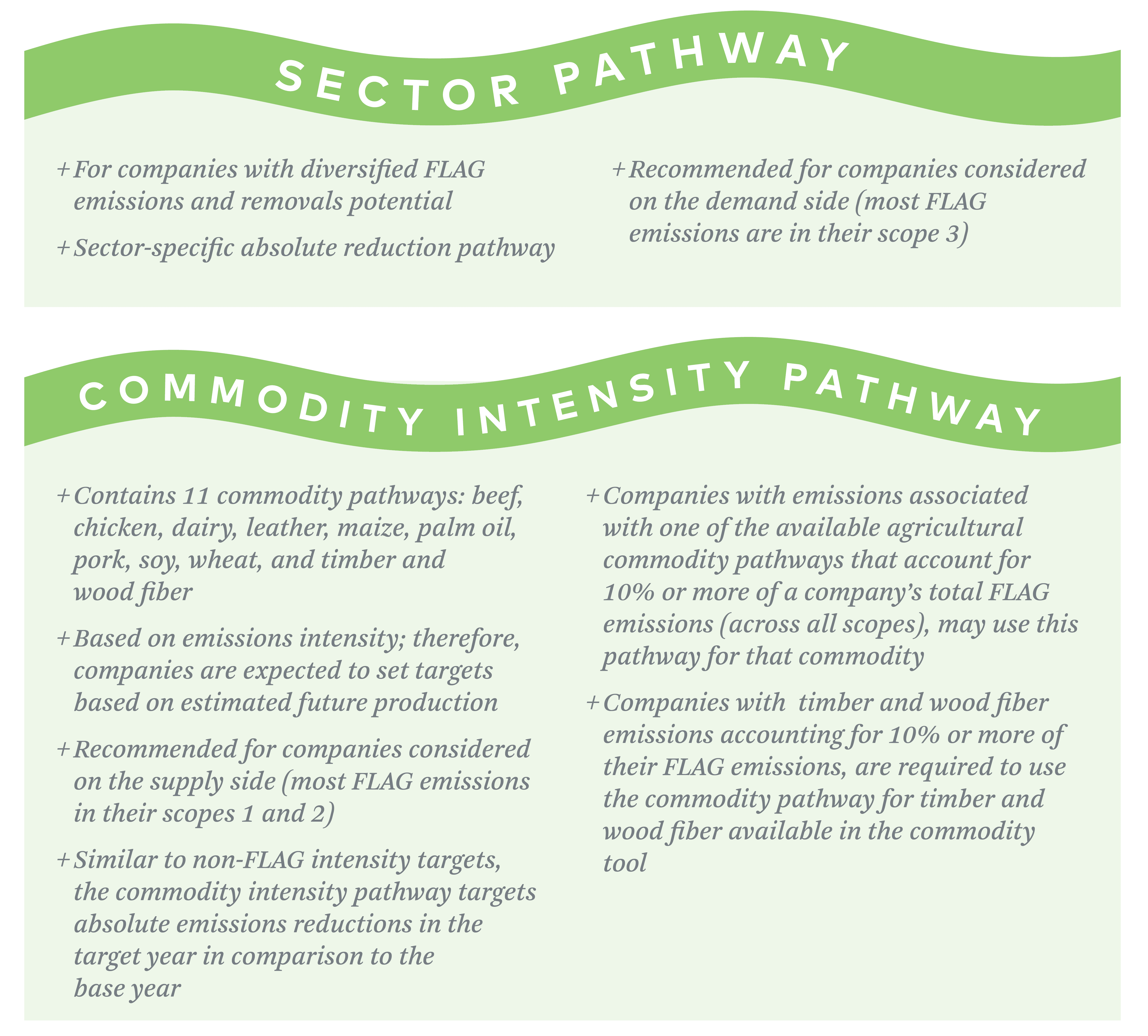
Carbon removals within the FLAG pathways
FLAG pathways are the only means by which companies can include biogenic carbon removals in their target-setting and reporting under SBTi. To be reported, nature-based removals must be in the company’s supply chain (e.g., on-farm/in-forest actions). Removals must be accounted for in line with GHG Protocol’s guidance, including the requirement that a company may only include biogenic removals in its inventory that have ongoing storage and monitoring. While technological removals are included in the GHGP guidance, reporting on this category of removals will be addressed in separate SBTi guidance.
While SBTi and GHG Protocol’s land sector guidance do not allow an organization to count a removal outside of its value chain towards its near-term targets (i.e., no carbon credits), the guidance documents do address accounting for the sale of carbon credits.
In the case where a carbon removal or reduction within an organization’s value chain is quantified and sold as a carbon credit, that organization –and any other organization accounting for the activity in its value chain– cannot claim such carbon removal or reduction. Removal projects can be accounted for either within a company’s supply chain and its FLAG target or as a carbon credit by the external buyer, but not both to avoid double counting.
Though companies are required to report gross emission and removals separately, the final FLAG target is a net reduction target that includes removals. This approach was adopted in order to maintain a focus on reducing cumulative emissions to the atmosphere, while separately increasing CO2 removals.
Complying with SBTi’s FLAG guidance
Although the SBTi guidance was released recently in September 2022, companies are already feeling its impact as the SBTi-committers have set a timeline of FLAG target compliance.
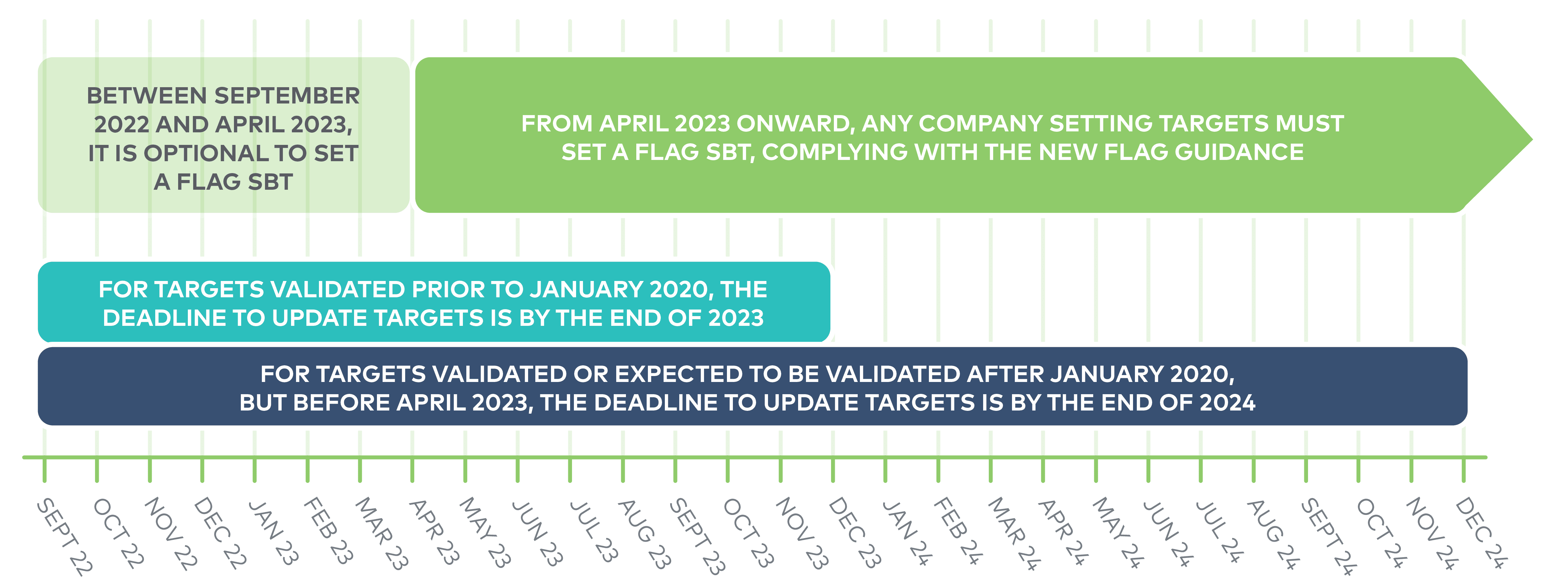
What should companies do to prepare for the new SBTi requirements on FLAG emissions?
In line with the compliance of SBTi’s FLAG guidance, there are eight steps that companies could take to prepare for the new SBTi requirements on FLAG emissions:

- Discovery: Get familiar with the new FLAG guidance and its implication on your emissions accounting and reporting. Determine if the new guidance is relevant to your company and if you will need to update your targets, if already set.
- Screening: Perform a screening exercise by reviewing your key operational activities connected to the land sector in order to identify and map your FLAG emissions, as well as their share in your total scope 1, 2 and 3. This will help identify whether or not you fall in a category of companies that needs to set FLAG targets.
- Target modelling: If the company is required to update or set new targets, the next step is to model targets using either the FLAG sector pathway or the commodity intensity pathway, or a mix of both, then identify the required emissions reductions and removals. Note that the SBTi criteria on forward-looking ambition also apply to FLAG targets.
- Target submission: Prepare the target submission package for target-setting, then update and submit it for validation. Both emissions reduction target and removal target will have to be submitted.
- Data: Develop a FLAG data collection process by identifying key data to be collected and key stakeholders to be involved; researching best databases to be used for emissions calculation for your specific case; having a platform or tool that works best for data collection and emissions calculation; and getting ready for an annual process of FLAG data collection and reporting. Currently GHG Protocol published only a draft version for its Land Sector and Removals Guidance and is recommended by SBTi, though there are various other guidance documents that could be used for reference before the new guidance is finalized.
- Strategy: Develop a company-wide strategy in order to advance towards your targets by identifying key levers in emissions reductions and removals.
- Action: Act towards achieving your targets. Similar to non-FLAG targets, FLAG targets have a timeframe between 5 and 10 years, in order to prioritize immediate action over long-term ambition.
- Follow up: Follow the latest versions of the SBTi FLAG guidance. An updated version of the FLAG guidance will follow after the GHG Protocol Land Sector and Removals Guidance is finished, to ensure alignment with corporate accounting guidance.
Emissions accounting and target-setting frameworks are constantly evolving, and SBTi acknowledges that the current version is only the first and updates will follow. As such, companies can have targets in place while continuing to improve their reporting through collaboration with suppliers.
Any adjustments to accounting methods should be disclosed and implemented per the GHG Protocol Corporate and Value Chain Standards. Any impact of those adjustments on the company’s targets should be assessed in line with SBTi criteria and recommendations, which call for target recalculation when major changes occur in inventories.
Additional requirements and recommendations of the FLAG guidance
The additional SBTi FLAG guidance requirements and recommendations are necessary in order to get a target validated.
These include:
No-deforestation commitment
Companies are required to publicly submit a no-deforestation commitment along with their FLAG target. The no-deforestation commitment is covering all emissions, and isn’t limited to the 67% emissions coverage requirement under scope 3. The target date is no later than 2025, with a recommended cutoff year of 2020. The target year represents the date by which the company intends to have fully implemented its commitment or policy, while the cutoff date represents the date after which deforestation is counted in a company’s supply chain for the purposes of this commitment.
Just transition
SBTi does not mandate how mitigation actions towards achieving the FLAG targets should be implemented. However, SBTi supports a “just transition,” and there are a number of important considerations that should be followed by companies implementing mitigation actions to meet their SBTi FLAG targets. In this context, companies should ensure climate equity and acknowledgement of carbon rights for farmers, foresters and landholders, including fair compensation for the implementation of mitigation efforts.
Net zero FLAG targets
Companies are encouraged to set FLAG Net Zero targets, though, like non-FLAG targets, the prerequisite to setting a net zero target is to have a short-term target. The target development and submission process follow the criteria that are already provided in the SBTi Net Zero guidance and Net Zero tool.
Since the FLAG sector represents almost a quarter of global greenhouse gas (GHG) emissions, the SBTi FLAG guidance seeks to redefine sustainable land use. Although an evolving project, organizations can count on this guidance as a first set of criteria and requirements to address their land-related emissions across all scopes of emissions.
The SBTi FLAG guidance helps provide a critically-important framework for organizations to make important progress in addressing their scope 1, 2, and 3 emissions. If you need help assessing the impact of the SBTi FLAG guidance on your company, or assistance setting climate targets in general, please reach out.


